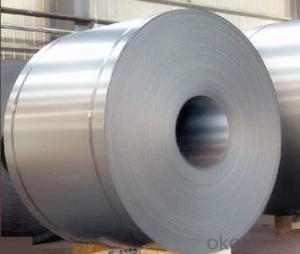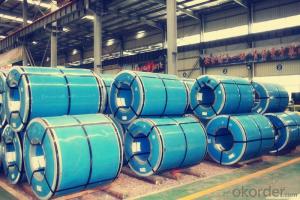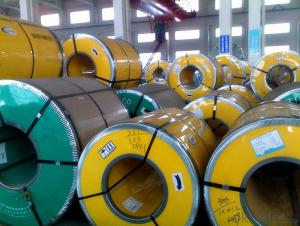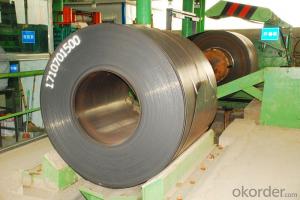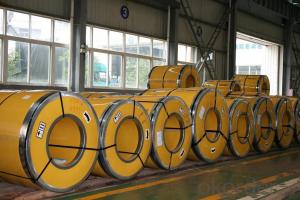Stainless Steel Coil Hot/Cold Rolled 201/304/430 Wide/Narrow Strip No.1/BA/2B Finish
OKorder Service Pledge
OKorder Financial Service
You Might Also Like
Hot / Cold Rolled Stainless Steel Coil
1. | Item | STAINLESS STEEL COIL | ||
2. | Standard | ASTM,AISI,GB,JIS,SUS,EN,DIN,etc. | ||
3. |
Material | 200 series | 300 series | 400 series |
201,202 | 300,301,304,304L,309S,310S,316Ti,316L, 317L,321,329,329LA,329LD | 409,410,430,430LX,600,601 | ||
4. |
Specification | Thickness | 0.1mm-200mm | |
Width | 1000mm-3000mm | |||
Length | 1m-12m | |||
5. | Surface | No.1,No.4,No.5,BA,2B,hair line,embossed,mirror finish,etc | ||
6. | Application | Stainless steel coils s are widely used in: 1:Chemical industry equipment,industrial tanks 2:Medical instruments,tableware,kitchen utensil,kitchen ware. 3:Architectural purpose,milk or food processing facilities. 4:Hospital equipment,interior exterior decoration for building 5:Architectural purposes,escalators,kitchen ware,vehicles. Or they can be made as your requirement. | ||
7. | Package | Standard export package. | ||
8. | Export to | Asia,Africa,Europe,Middle East,South and North America,Oceania,etc | ||
9. | Contact | please feel free to contact us | ||
- Q: What is the hardness of stainless steel strips?
- The hardness of stainless steel strips can vary depending on the specific grade and heat treatment, but generally they have a hardness range of 150 to 250 on the Vickers hardness scale.
- Q: Are 111 stainless steel strips suitable for high-wear applications?
- No, 111 stainless steel strips are not suitable for high-wear applications. While stainless steel is generally known for its corrosion resistance and durability, the specific grade 111 falls under the austenitic stainless steel category, which is less resistant to wear and tear compared to other grades such as 304 or 316. In high-wear applications, where the material is subjected to constant friction, abrasion, or impact, it is advisable to use a higher-grade stainless steel to ensure better performance and longevity.
- Q: Can 111 stainless steel strips be coated with anti-fouling coatings?
- Yes, 111 stainless steel strips can be coated with anti-fouling coatings.
- Q: Can stainless steel strips be used for electrical connectors?
- Yes, stainless steel strips can be used for electrical connectors. Stainless steel is a versatile material that offers excellent electrical conductivity, corrosion resistance, and mechanical strength. These properties make it suitable for various applications, including electrical connectors. Stainless steel strips can be formed into different shapes, such as pins or terminals, and can be used to establish electrical connections between components or wires. Additionally, stainless steel is widely used in electrical connectors for its durability and ability to withstand high temperatures, making it a reliable choice for many electrical systems.
- Q: What are the different grades available in 111 stainless steel strips?
- There are different grades available in 111 stainless steel strips, including grade 301, grade 304, and grade 316.
- Q: How do stainless steel strips handle exposure to caustic solutions?
- Stainless steel strips are highly resistant to caustic solutions due to their corrosion-resistant properties. They can withstand prolonged exposure to caustic solutions without undergoing any significant damage or corrosion, making them a reliable choice for applications in industries such as chemical processing, food processing, and pharmaceuticals.
- Q: Can stainless steel strips be used in the electronics industry?
- Indeed, the electronics industry can utilize stainless steel strips. Stainless steel, being a versatile material, presents numerous advantages for electronics applications. Its outstanding corrosion resistance plays a crucial role in safeguarding electronic components against moisture and other environmental elements. Moreover, stainless steel exhibits commendable thermal conductivity, making it appropriate for heat transfer applications in electronic devices. Furthermore, its robustness and durability render it suitable for employment in electronic enclosures, connectors, and frames. All in all, stainless steel strips offer a dependable and enduring solution for the electronics industry.
- Q: What is the thermal conductivity of stainless steel strips at different temperatures?
- The thermal conductivity of stainless steel strips can vary depending on the specific grade of stainless steel and the temperature at which it is measured. However, in general, stainless steel is known for its relatively low thermal conductivity compared to other metals. At room temperature (around 25°C or 77°F), the thermal conductivity of stainless steel strips typically ranges from 14 to 19 watts per meter-kelvin (W/m·K). As the temperature increases, the thermal conductivity of stainless steel tends to decrease slightly. For example, at elevated temperatures such as 200°C (392°F), the thermal conductivity of stainless steel may decrease to around 12 to 17 W/m·K. Similarly, at extremely high temperatures, such as 1000°C (1832°F), the thermal conductivity of stainless steel can further decrease to approximately 8 to 12 W/m·K. It is important to note that these values are approximate and can vary depending on factors such as the specific alloy composition, impurities, and processing methods used in manufacturing the stainless steel strips. Therefore, for accurate and precise thermal conductivity values at different temperatures, it is recommended to consult the technical datasheet or contact the manufacturer of the specific stainless steel strip being used.
- Q: Are stainless steel strips resistant to fire?
- Yes, stainless steel strips are highly resistant to fire. Stainless steel is known for its exceptional heat resistance properties. It has a high melting point, which means it can withstand high temperatures without losing its structural integrity. Stainless steel strips also have a low thermal conductivity, meaning they do not conduct heat well, making them more resistant to fire. Additionally, stainless steel contains chromium, which forms a protective oxide layer on its surface when exposed to heat. This oxide layer acts as a barrier, preventing oxygen from reaching the steel and further enhancing its fire resistance. As a result, stainless steel strips are widely used in various applications where fire resistance is a critical requirement, such as construction, automotive, and aerospace industries.
- Q: Can stainless steel strips be used in the production of HVAC grilles?
- Yes, stainless steel strips can be used in the production of HVAC grilles. Stainless steel is a durable and corrosion-resistant material, making it suitable for HVAC applications. It provides strength and longevity, ensuring the grilles can withstand the demands of heating, ventilation, and air conditioning systems.
Send your message to us
Stainless Steel Coil Hot/Cold Rolled 201/304/430 Wide/Narrow Strip No.1/BA/2B Finish
OKorder Service Pledge
OKorder Financial Service
Similar products
Hot products
Hot Searches
Related keywords
